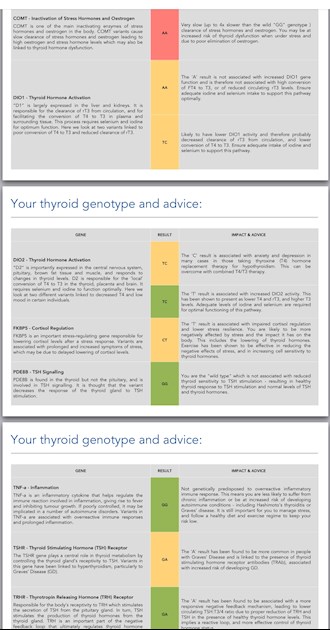I’m just wondering if this suggests I should try T4/T3 combo - would these results be worth discussing with an Endo?
Also I have Mirena Coil and Oestrogen patch....maybe ditch the patch?
I know I don’t handle stress well and believe prolonged stress caused my Hashimotos...
The TSHR - is odd as I am Hypothyroid..?
Any suggestions what I do with this info greatly appreciated 🙏
I will type the results as the image is unclear and have only done
Amber and Red results.....
Gene - COMT - Inactivation of Stress hormone and Oestrogen -
COMT is one of the main inactivating enzymes of stress
hormones and oestrogen in the body. COMT variants cause
slow clearance of stress hormones and oestrogen leading to
high oestrogen and stress hormone levels which may also be
linked to thyroid hormone dysfunction.
RESULT - RED AA -
Impact and advice - Very slow (up to 4x slower than the wild "GG" genotype )
clearance of stress hormones and oestrogen. You may be at
increased risk of thyroid dysfunction when under stress and
due to poor elimination of oestrogen.
DIO1 - Thyroid Hormone Activation
“D1” is largely expressed in the liver and kidneys. It is
responsible for the clearance of rT3 from circulation, and for
facilitating the conversion of T4 to T3 in plasma and
surrounding tissue. This process requires selenium and iodine
for optimum function. Here we look at two variants linked to
poor conversion of T4 to T3 and reduced clearance of rT3.
RESULT - AMBER AA -
The 'A' result is not associated with increased DIO1 gene
function and is therefore not associated with high conversion
of FT4 to T3, or of reduced circulating rT3 levels. Ensure
adequate iodine and selenium intake to support this pathway
optimally.
RESULT - AMBER TC -
Likely to have lower DIO1 activity and therefore probably
decreased clearance of rT3 from circulation, and lower
conversion of T4 to T3. Ensure adequate intake of iodine and
selenium to support this pathway.
DIO2 - Thyroid Hormone Activation
“D2” is importantly expressed in the central nervous system,
pituitary, brown fat tissue and muscle, and responds to
changes in thyroid levels. D2 is responsible for the ‘local’
conversion of T4 to T3 in the thyroid, placenta and brain. It
requires selenium and iodine to function optimally. Here we
look at two different variants linked to decreased T4 and low
mood in certain individuals.
RESULT - AMBER TC -
The 'C' result is associated with anxiety and depression in
many cases in those taking thyroxine (T4) hormone
replacement therapy for hypothyroidism. This can be
overcome with combined T4/T3 therapy.
RESULT - GREEN TC -
The 'T' result is associated with increased DIO2 activity. This
has been shown to present as lower T4 and rT3, and higher T3
levels. Adequate levels of iodine and selenium are required
for optimal functioning of this pathway.
FKBP5 - Cortisol Regulation
FKBP5 is an important stress-regulating gene responsible for
lowering cortisol levels after a stress response. Variants are
associated with prolonged and increased symptoms of stress,
which may be due to delayed lowering of cortisol levels.
RESULT - AMBER CT -
The 'T' result is associated with impaired cortisol regulation
and lower stress resilience. You are likely to be more
negatively affected by stress and the impact it has on the
body. This includes the lowering of thyroid hormones.
Exercise has been shown to be effective in reducing the
negative effects of stress, and in increasing cell sensitivity to
thyroid hormones.
TSHR - Thyroid Stimulating Hormone (TSH) Receptor
The TSHR gene plays a central role in thyroid metabolism by
controlling the thyroid gland’s receptivity to TSH. Variants in
this gene have been linked to hyperthyroidism, particularly to
Graves’ Disease (GD).
RESULT - AMBER GA -
The 'A' result has been found to be more common in people
with Graves' Disease and is linked to the presence of thyroid
stimulating hormone receptor antibodies (TRAb), associated
with increased risk of developing GD.

